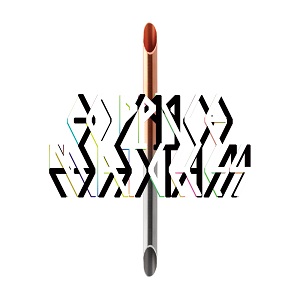Coppice, "Matches"
 Perspective in film or literature is an easy enough concept to explain. Appeals to height and distance or attitude and intention help situate what it means for a director or author to have a view of something, even if the subject matter is abstract. Perspective in music requires a little more: more context, more imagination, more patience maybe. Program music utilizes narrative by design, but what about music that is supposed to have eliminated narrative, that is intended as sound and not as storytelling? What about an album like Coppice’s Matches? Noé Cuéllar and Joseph Kramer’s second album this year is a puzzle box of rattling noise and growling materials, drawn from shruti boxes, pump organs, and sphygmomanometers. In that way, it is reminiscent of Cores/Eruct, a record that alternately divulged and concealed the architecture behind its construction, and which utilized music recorded and performed since 2009. Matches also incorporates music from the last six years: studio recordings and live performances from Texas, Illinois, and Iceland. It is set apart by its focus, by its cleaving to claustrophobic spaces, its tight framing, and its mechanical sequences, by the perspective it brings to Coppice’s corner of the musical cosmos. Cuéllar and Kramer have called Matches a "story with many holes." Whether they are presenting a tattered cloth or a series of missing pieces, and whether there is a difference between the two, is a question worth keeping in mind as the album folds, unfolds, and spins through its many configurations.
Perspective in film or literature is an easy enough concept to explain. Appeals to height and distance or attitude and intention help situate what it means for a director or author to have a view of something, even if the subject matter is abstract. Perspective in music requires a little more: more context, more imagination, more patience maybe. Program music utilizes narrative by design, but what about music that is supposed to have eliminated narrative, that is intended as sound and not as storytelling? What about an album like Coppice’s Matches? Noé Cuéllar and Joseph Kramer’s second album this year is a puzzle box of rattling noise and growling materials, drawn from shruti boxes, pump organs, and sphygmomanometers. In that way, it is reminiscent of Cores/Eruct, a record that alternately divulged and concealed the architecture behind its construction, and which utilized music recorded and performed since 2009. Matches also incorporates music from the last six years: studio recordings and live performances from Texas, Illinois, and Iceland. It is set apart by its focus, by its cleaving to claustrophobic spaces, its tight framing, and its mechanical sequences, by the perspective it brings to Coppice’s corner of the musical cosmos. Cuéllar and Kramer have called Matches a "story with many holes." Whether they are presenting a tattered cloth or a series of missing pieces, and whether there is a difference between the two, is a question worth keeping in mind as the album folds, unfolds, and spins through its many configurations.
The loud, long, and reedy drone that begins and continues throughout all six and a quarter minutes of "Bromine" implies that Noé and Joseph interpret the matter of musical perspective spatially. Shruti boxes and pump organs are mainstays in their repertoire, instruments they have portrayed from different vantage points over numerous full-lengths, EPs, cassettes, and CD-Rs, but this intense closeup, which produces a metallic, insect-like buzz, fills the song’s entire frame and is unique in its consistency and nakedness. The only accompaniment are a few squeaking noises, which might be from the bellows or the case of a shruti box, and a handful of mysterious overtones.
It resolves seamlessly into "Labile Form," the contents of which are more varied: a few convulsing melodies, more tactile noises like rattling springs and spinning tape heads, and a deep, satisfying bass tone. As it concludes, the track shakes and trembles like the mic has been dropped into a leather bag and let loose in a wind tunnel. Much of what happens during Matches seems to happen from the inside out, and that might be one way of thinking about the group’s insistence that this album be "handled from all sides."
Another way would be to think about how Cuéllar and Kramer recycle their previous work. "Held Cascade" and "Bramble" both employ Vinculum recordings, an archive of CD-Rs the band describes as "sonic artifacts." An album that uses previously recorded material could be seen as a tool for re-seeing and rethinking that material, either on its own or in relation to a bigger picture. It’s impossible to determine the origins for any of these parts in the first place, as the album is a kind of reconstructed compilation of previously recorded sounds. The "story with many holes" would be, in that case, a story composed of holes, of segments tied together to form the illusion of a whole. It's a kind of retrospective, but with the added twist that it’s a synthetic retrospective representative of nothing beyond itself. The organizational principle is partly intuitive and partly mechanical, a map of the way every part interacts, relates, and behaves.
Theoretical considerations about parts and wholes aside, the music is surprisingly cohesive. The sizzle of electrical systems, the crackle of distorted tapes, and the chunky rhythms of songs like "Bramble" and "Caper" are all heavy. They feel and sound like physical forces, not just loud and insistent noises. They’re broad and dense things made up of identifiable elements: wood, metal, rubber, magnetic film, pressurized air, each one of their audible instances matching their physical forms. Whether that is what Coppice means by naming their album Matches is questionable. They pair and blend musical sources on this record, but they also set them against one another, creating a music of conflict and agitation. Telling the two apart is, in the case, a matter of perspective.
samples:
 



